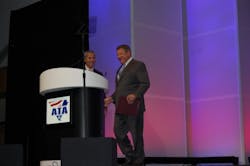PHILADELPHIA. Congressman Bill Shuster (R-PA), chairman of the transportation and infrastructure committee within the House of Representatives, expressed “confidence” that a long-term highway bill “can get done” and sent to the White House, though more time will be needed to do so.
“We need a multi-year highway bill; we need that certainty,” he said during a speech here at the 2105 American Trucking Associations (ATA) Management Conference & Exposition (MC&E).
“When I’ve asked stakeholders, ‘What’s more important: more money of a long-term bill?’ They’ve unanimously responded ‘A long term bill,’” Shuster added. “That kind of certainty is critical.”
He noted, though, that one more short-term funding “patch” will mostly likely be needed to allow time for the Senate and the House to reconcile their separate transportation funding proposals: the Senate’s Developing a Reliable and Innovative Vision for the Economy (DRIVE) Act put on the legislative table back in late June and the House’s recent Surface Transportation Reauthorization and Reform Act of 2015.“Current funding expires at the end of this month so we’ll almost assuredly pass another [short-term patch] to gain time for the long-term bill,” Shuster explained.
That time is necessary because “there are big differences between the Senate and House bills,” he stressed, though Shuster hopes “to work out those differences in conference.”
He emphasized that trucking is a large focal point of the House bill, as trucks moved 70% of all U.S. freight in 2012 – over 13 billion tons valued at more than $12 trillion – and by 2040, trucks will be relied upon to move 42% more freight than in 2012.
“This [White House] administration has been very hostile to your industry over the last seven years; you’ve had to fight an uphill battle,” Shuster noted. “But roads and trucks are vital to our economy and to our quality of life. Traffic congestion is only going to grow worse; that’s why we need a long term bill.”
Some of the trucking-specific and related components within the House’s bill include:
- The creation of a Nationally Significant Freight and Highway Projects program funded at $4.5 billion for fiscal years 2016 through 2021 for large-scale projects of national or regional importance;
- Overhauling federal truck and bus safety grant programs and rulemaking processes;
- Reforming and consolidating truck and bus safety programs while easing administrative burdens on small businesses;
- Providing competitive grant options to address truck and bus facility needs;
- Encouraging the installation of vehicle-to-infrastructure equipment to reduce congestion and improve safety;
- Provides flexibility for states to invest in bridge rehabilitation and replacement while eliminating red tape that slows down infrastructure improvements;
- Streamlines the environmental review and permitting process to cut red tape and accelerate project delivery;
- Provides more flexibility and decision-making to states and local governments to allow them to better address their priorities and needs;
- Eliminates and consolidates offices within the Department of Transportation.
Shuster referred to trucking as “the backbone of America” and hoped that a long-term bill would only improve the industry’s capability.
“It’s all about reform, reform, reform; we’re living in a completely different fiscal reality than a decade ago and we need to allow more freedom for innovation, to free the industry from excessive regulation,” he emphasized.
Shuster added, though, that even more far-reaching work needs to be done once a long-term bill is passed so battles over how to fund surface transportation are not refought all over again.
“We all need to come together to find some sort of acceptable [funding] solution so we can move forward, for if not, in six years we’ll face the same problems and same fights again,” he said. “Trucking needs to ask itself: where are you going to be? You need to be united when you come to Washington D.C. or your state capitols, because if you fight amongst yourselves, when that happens, it is death by a thousand cuts.”




